CHRYSLER ASPEN 2009 2.G Owners Manual
Manufacturer: CHRYSLER, Model Year: 2009, Model line: ASPEN, Model: CHRYSLER ASPEN 2009 2.GPages: 481, PDF Size: 9.28 MB
Page 381 of 481
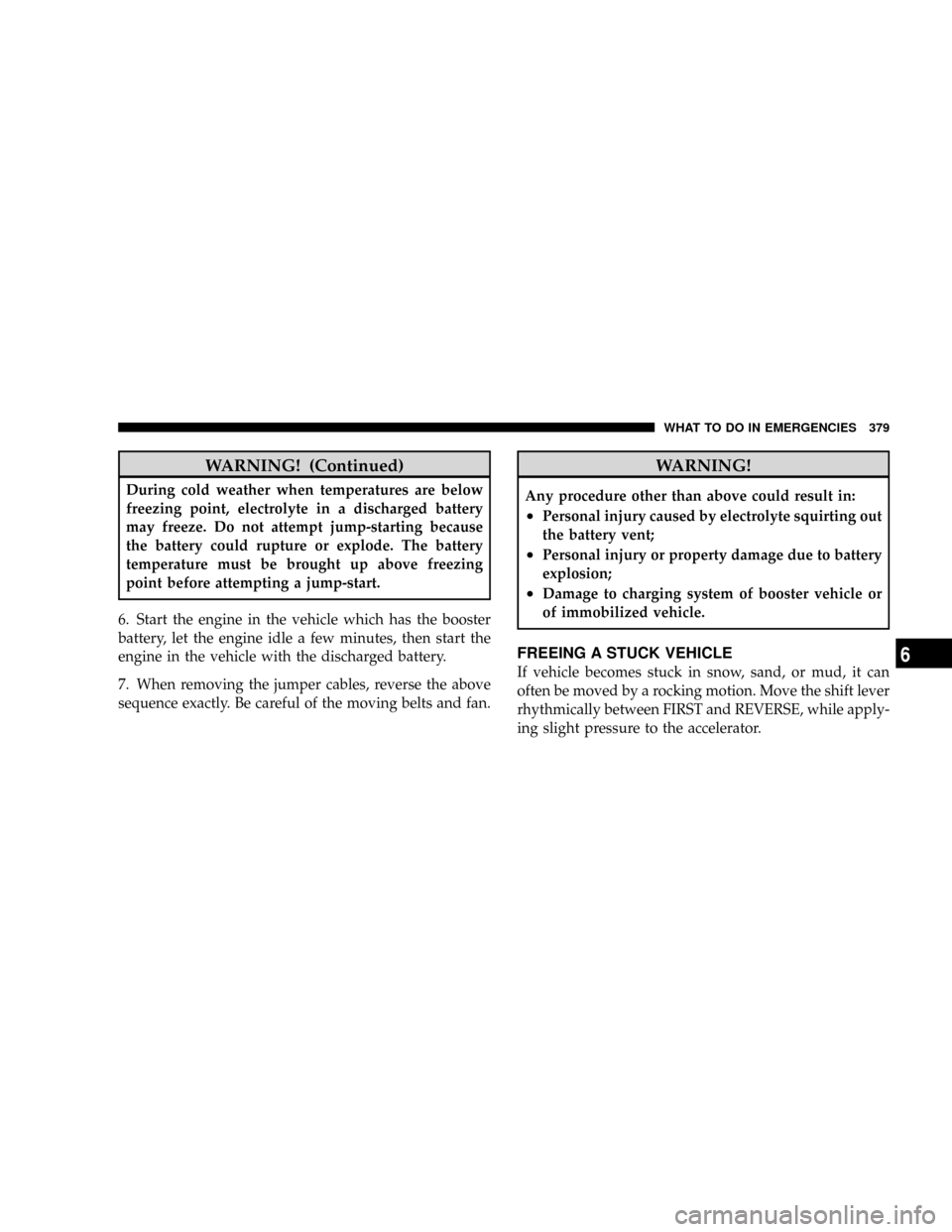
WARNING! (Continued)
During cold weather when temperatures are below
freezing point, electrolyte in a discharged battery
may freeze. Do not attempt jump-starting because
the battery could rupture or explode. The battery
temperature must be brought up above freezing
point before attempting a jump-start.
6. Start the engine in the vehicle which has the booster
battery, let the engine idle a few minutes, then start the
engine in the vehicle with the discharged battery.
7. When removing the jumper cables, reverse the above
sequence exactly. Be careful of the moving belts and fan.
WARNING!
Any procedure other than above could result in:
²Personal injury caused by electrolyte squirting out
the battery vent;
²Personal injury or property damage due to battery
explosion;
²Damage to charging system of booster vehicle or
of immobilized vehicle.
FREEING A STUCK VEHICLE
If vehicle becomes stuck in snow, sand, or mud, it can
often be moved by a rocking motion. Move the shift lever
rhythmically between FIRST and REVERSE, while apply-
ing slight pressure to the accelerator.
WHAT TO DO IN EMERGENCIES 379
6
Page 382 of 481
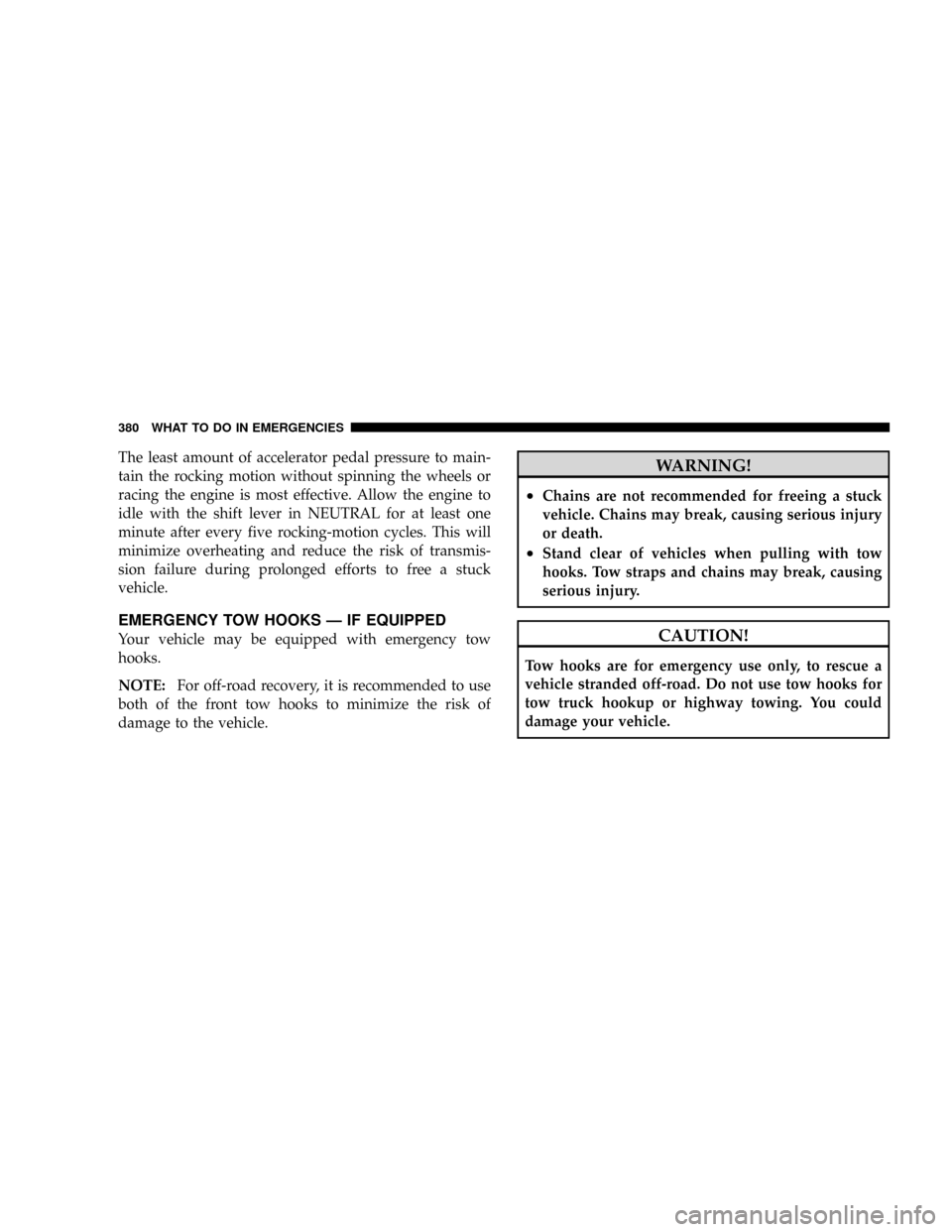
The least amount of accelerator pedal pressure to main-
tain the rocking motion without spinning the wheels or
racing the engine is most effective. Allow the engine to
idle with the shift lever in NEUTRAL for at least one
minute after every five rocking-motion cycles. This will
minimize overheating and reduce the risk of transmis-
sion failure during prolonged efforts to free a stuck
vehicle.
EMERGENCY TOW HOOKS Ð IF EQUIPPED
Your vehicle may be equipped with emergency tow
hooks.
NOTE:For off-road recovery, it is recommended to use
both of the front tow hooks to minimize the risk of
damage to the vehicle.
WARNING!
²Chains are not recommended for freeing a stuck
vehicle. Chains may break, causing serious injury
or death.
²Stand clear of vehicles when pulling with tow
hooks. Tow straps and chains may break, causing
serious injury.
CAUTION!
Tow hooks are for emergency use only, to rescue a
vehicle stranded off-road. Do not use tow hooks for
tow truck hookup or highway towing. You could
damage your vehicle.
380 WHAT TO DO IN EMERGENCIES
Page 383 of 481
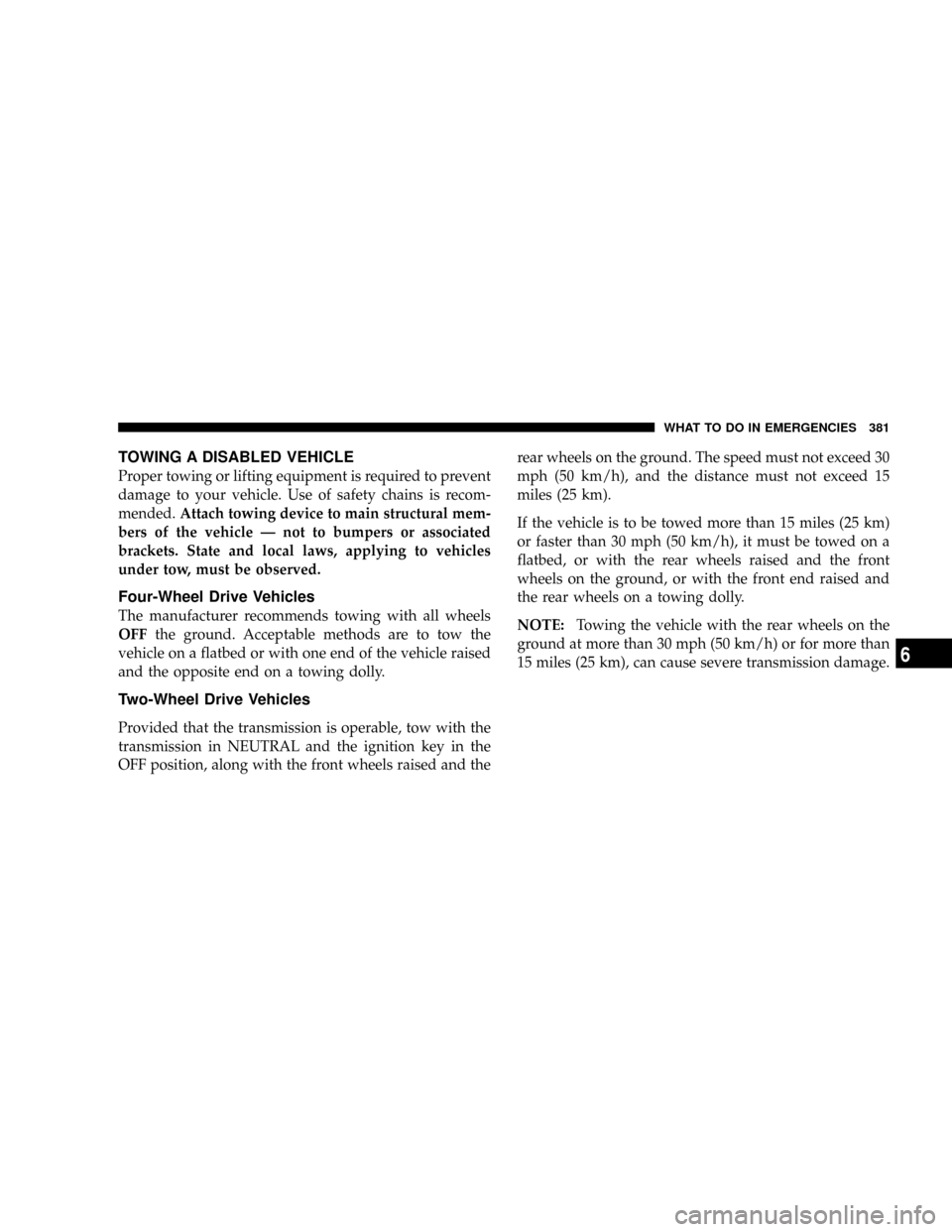
TOWING A DISABLED VEHICLE
Proper towing or lifting equipment is required to prevent
damage to your vehicle. Use of safety chains is recom-
mended.Attach towing device to main structural mem-
bers of the vehicle Ð not to bumpers or associated
brackets. State and local laws, applying to vehicles
under tow, must be observed.
Four-Wheel Drive Vehicles
The manufacturer recommends towing with all wheels
OFFthe ground. Acceptable methods are to tow the
vehicle on a flatbed or with one end of the vehicle raised
and the opposite end on a towing dolly.
Two-Wheel Drive Vehicles
Provided that the transmission is operable, tow with the
transmission in NEUTRAL and the ignition key in the
OFF position, along with the front wheels raised and therear wheels on the ground. The speed must not exceed 30
mph (50 km/h), and the distance must not exceed 15
miles (25 km).
If the vehicle is to be towed more than 15 miles (25 km)
or faster than 30 mph (50 km/h), it must be towed on a
flatbed, or with the rear wheels raised and the front
wheels on the ground, or with the front end raised and
the rear wheels on a towing dolly.
NOTE:Towing the vehicle with the rear wheels on the
ground at more than 30 mph (50 km/h) or for more than
15 miles (25 km), can cause severe transmission damage.
WHAT TO DO IN EMERGENCIES 381
6
Page 384 of 481

Page 385 of 481
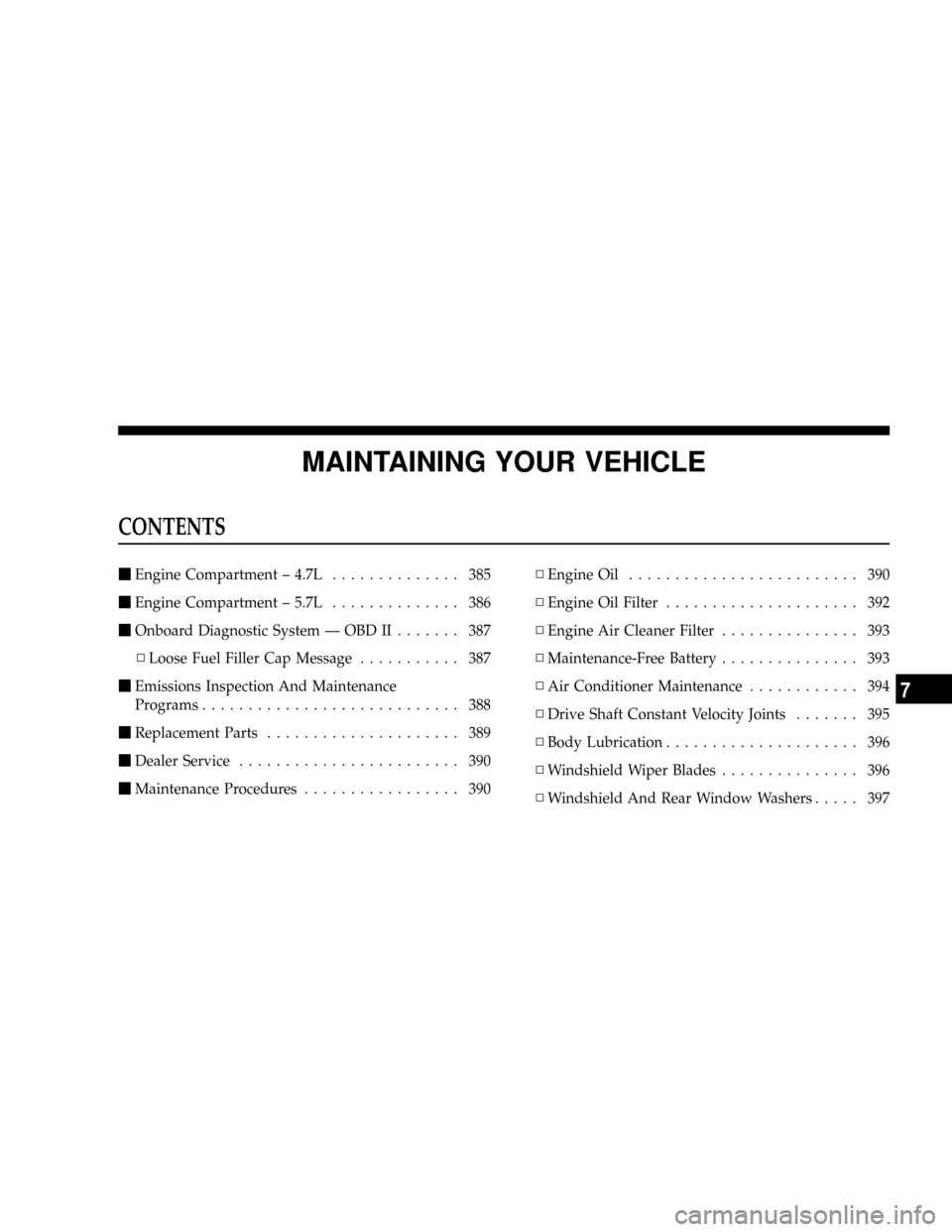
MAINTAINING YOUR VEHICLE
CONTENTS
mEngine Compartment ± 4.7L.............. 385
mEngine Compartment ± 5.7L.............. 386
mOnboard Diagnostic System Ð OBD II....... 387
NLoose Fuel Filler Cap Message........... 387
mEmissions Inspection And Maintenance
Programs............................ 388
mReplacement Parts..................... 389
mDealer Service........................ 390
mMaintenance Procedures................. 390NEngine Oil......................... 390
NEngine Oil Filter..................... 392
NEngine Air Cleaner Filter............... 393
NMaintenance-Free Battery............... 393
NAir Conditioner Maintenance............ 394
NDrive Shaft Constant Velocity Joints....... 395
NBody Lubrication..................... 396
NWindshield Wiper Blades............... 396
NWindshield And Rear Window Washers..... 397
7
Page 386 of 481
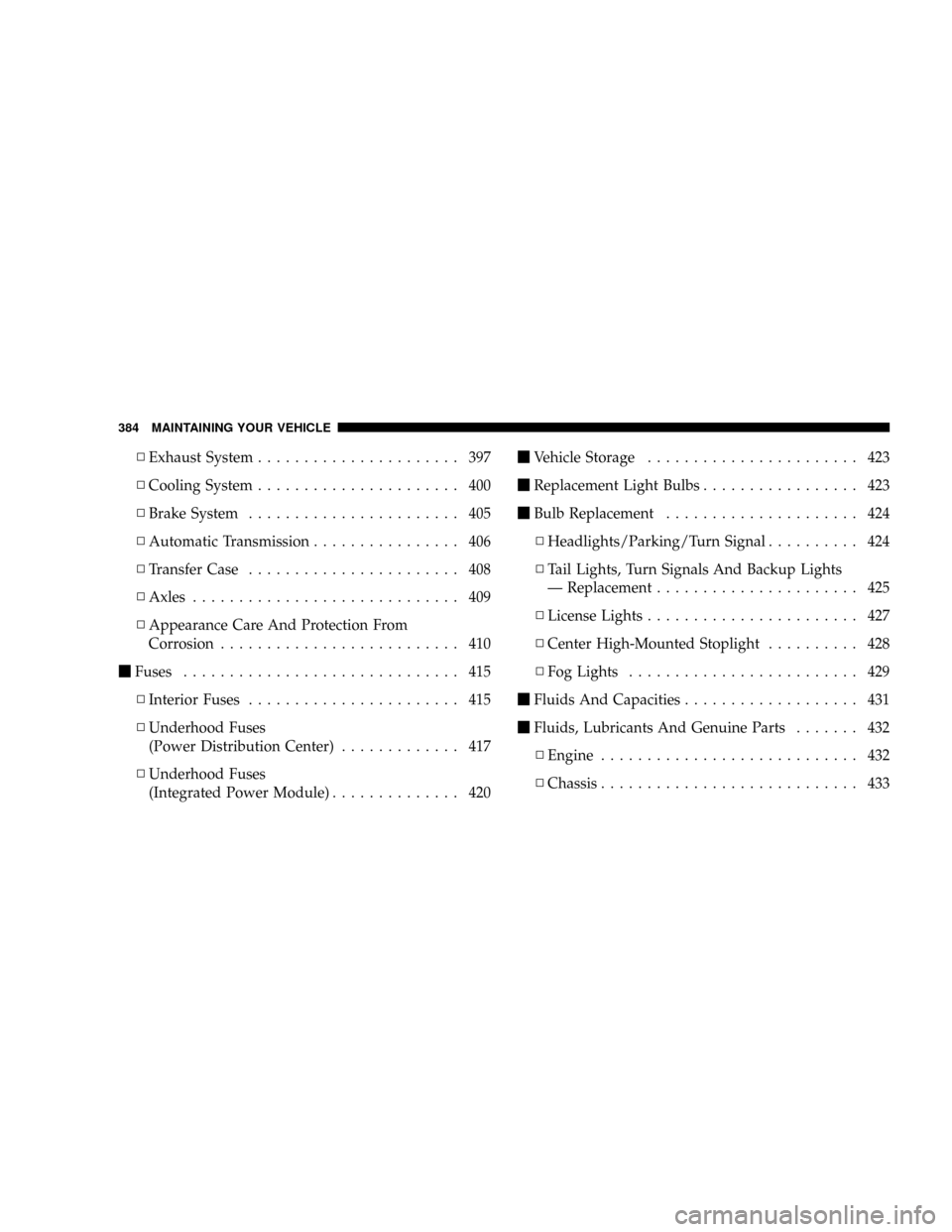
NExhaust System...................... 397
NCooling System...................... 400
NBrake System....................... 405
NAutomatic Transmission................ 406
NTransfer Case....................... 408
NAxles............................. 409
NAppearance Care And Protection From
Corrosion.......................... 410
mFuses.............................. 415
NInterior Fuses....................... 415
NUnderhood Fuses
(Power Distribution Center)............. 417
NUnderhood Fuses
(Integrated Power Module).............. 420mVehicle Storage....................... 423
mReplacement Light Bulbs................. 423
mBulb Replacement..................... 424
NHeadlights/Parking/Turn Signal.......... 424
NTail Lights, Turn Signals And Backup Lights
Ð Replacement...................... 425
NLicense Lights....................... 427
NCenter High-Mounted Stoplight.......... 428
NFog Lights......................... 429
mFluids And Capacities................... 431
mFluids, Lubricants And Genuine Parts....... 432
NEngine............................ 432
NChassis............................ 433
384 MAINTAINING YOUR VEHICLE
Page 387 of 481
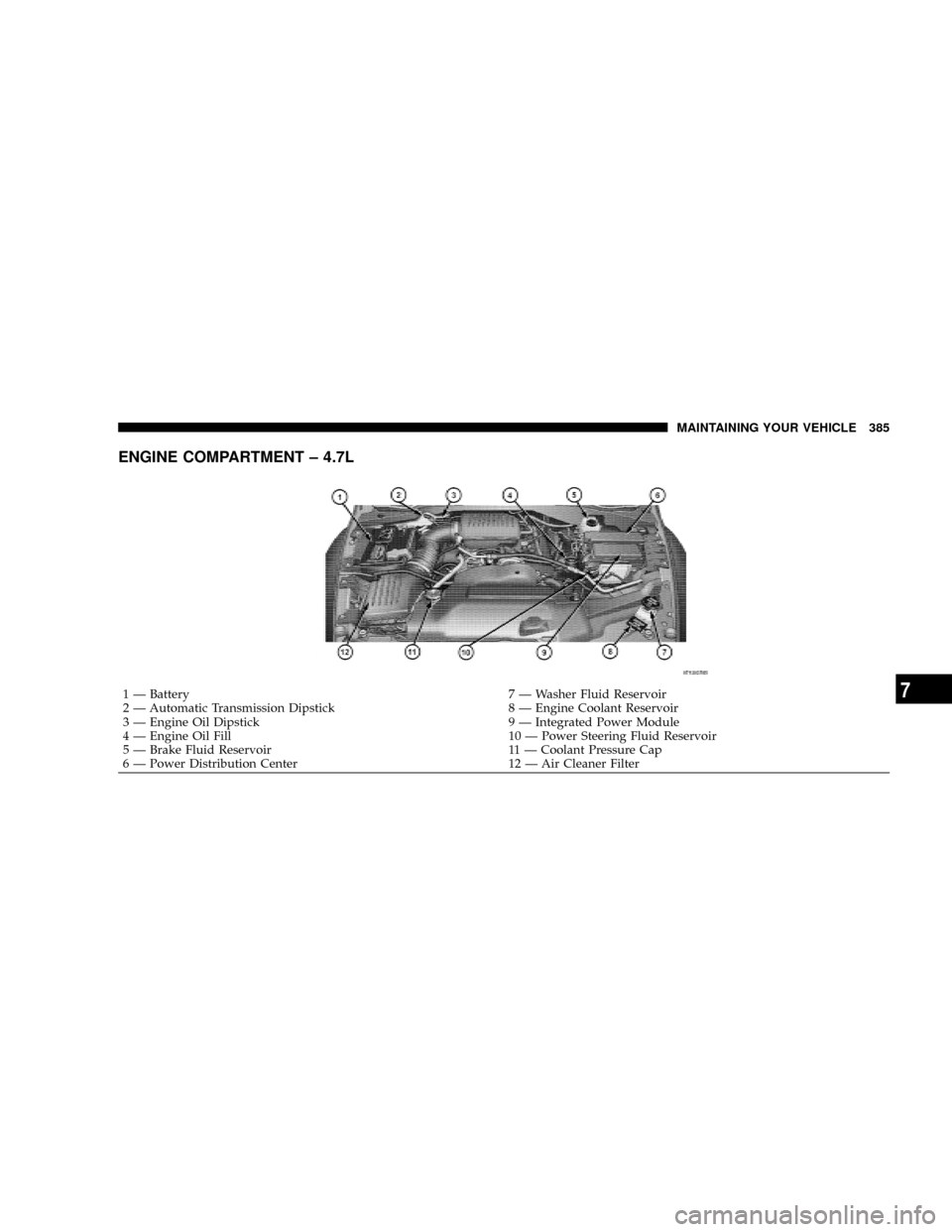
ENGINE COMPARTMENT ± 4.7L
1 Ð Battery 7 Ð Washer Fluid Reservoir
2 Ð Automatic Transmission Dipstick 8 Ð Engine Coolant Reservoir
3 Ð Engine Oil Dipstick 9 Ð Integrated Power Module
4 Ð Engine Oil Fill 10 Ð Power Steering Fluid Reservoir
5 Ð Brake Fluid Reservoir 11 Ð Coolant Pressure Cap
6 Ð Power Distribution Center 12 Ð Air Cleaner FilterMAINTAINING YOUR VEHICLE 3857
Page 388 of 481
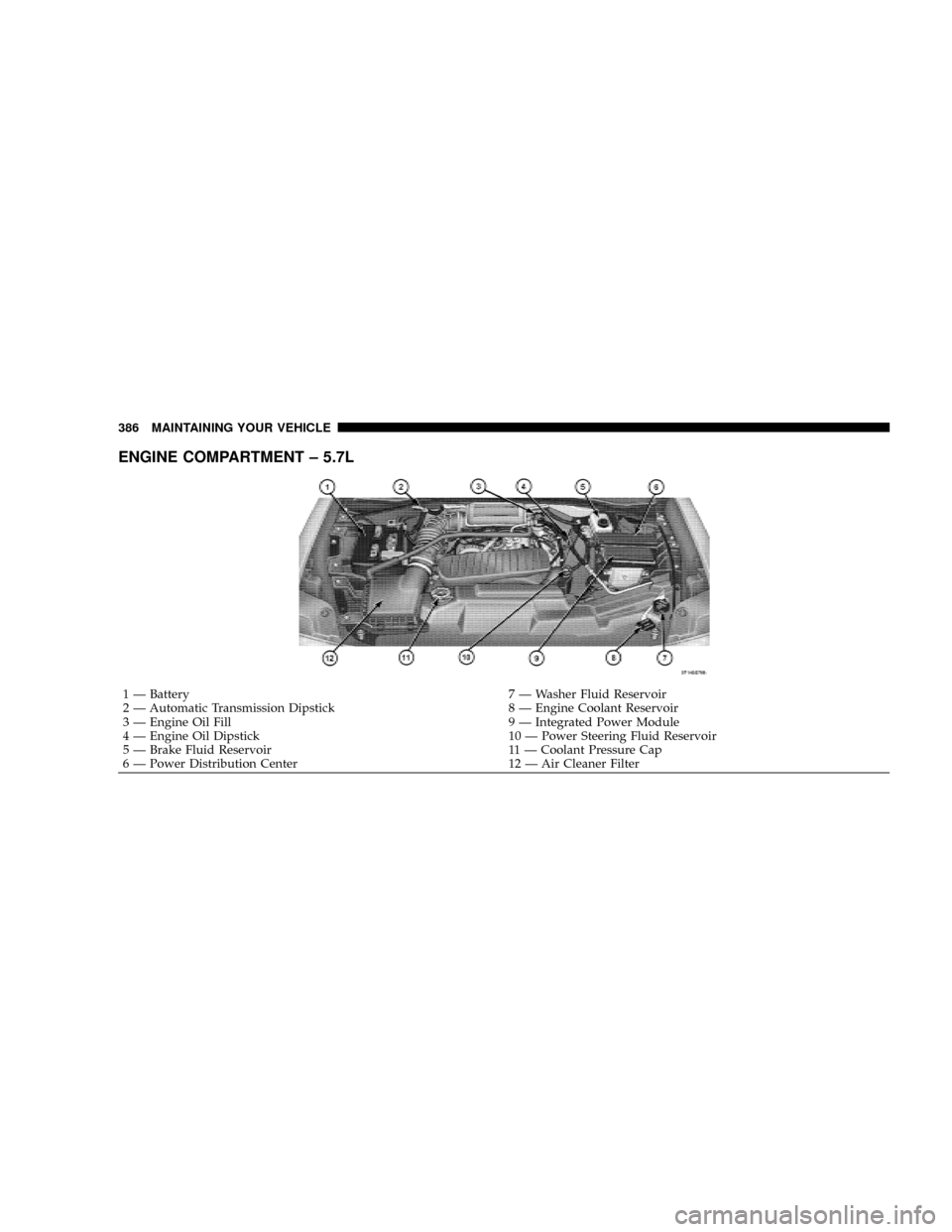
ENGINE COMPARTMENT ± 5.7L
1 Ð Battery 7 Ð Washer Fluid Reservoir
2 Ð Automatic Transmission Dipstick 8 Ð Engine Coolant Reservoir
3 Ð Engine Oil Fill 9 Ð Integrated Power Module
4 Ð Engine Oil Dipstick 10 Ð Power Steering Fluid Reservoir
5 Ð Brake Fluid Reservoir 11 Ð Coolant Pressure Cap
6 Ð Power Distribution Center 12 Ð Air Cleaner Filter 386 MAINTAINING YOUR VEHICLE
Page 389 of 481
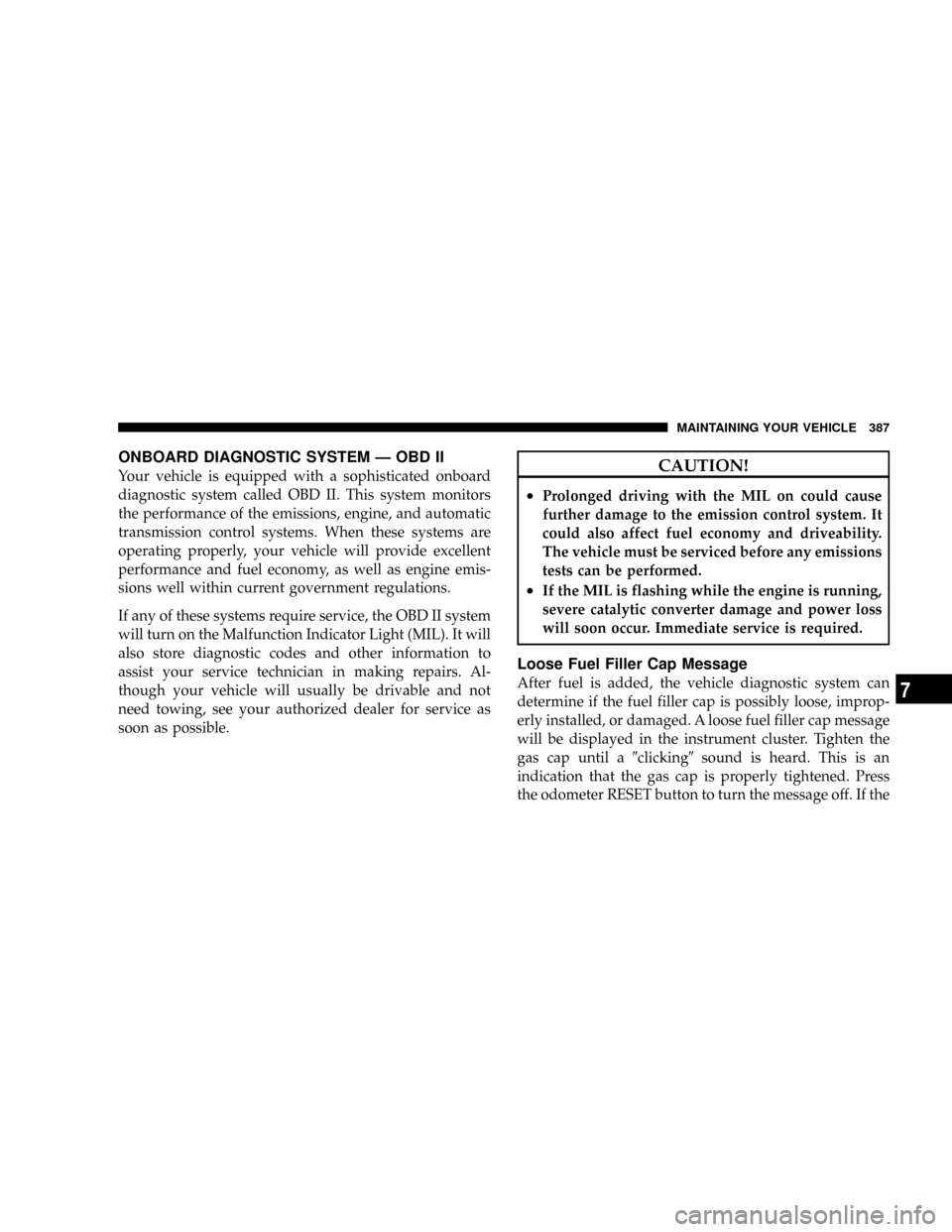
ONBOARD DIAGNOSTIC SYSTEM Ð OBD II
Your vehicle is equipped with a sophisticated onboard
diagnostic system called OBD II. This system monitors
the performance of the emissions, engine, and automatic
transmission control systems. When these systems are
operating properly, your vehicle will provide excellent
performance and fuel economy, as well as engine emis-
sions well within current government regulations.
If any of these systems require service, the OBD II system
will turn on the Malfunction Indicator Light (MIL). It will
also store diagnostic codes and other information to
assist your service technician in making repairs. Al-
though your vehicle will usually be drivable and not
need towing, see your authorized dealer for service as
soon as possible.CAUTION!
²Prolonged driving with the MIL on could cause
further damage to the emission control system. It
could also affect fuel economy and driveability.
The vehicle must be serviced before any emissions
tests can be performed.
²If the MIL is flashing while the engine is running,
severe catalytic converter damage and power loss
will soon occur. Immediate service is required.
Loose Fuel Filler Cap Message
After fuel is added, the vehicle diagnostic system can
determine if the fuel filler cap is possibly loose, improp-
erly installed, or damaged. A loose fuel filler cap message
will be displayed in the instrument cluster. Tighten the
gas cap until a9clicking9sound is heard. This is an
indication that the gas cap is properly tightened. Press
the odometer RESET button to turn the message off. If the
MAINTAINING YOUR VEHICLE 387
7
Page 390 of 481
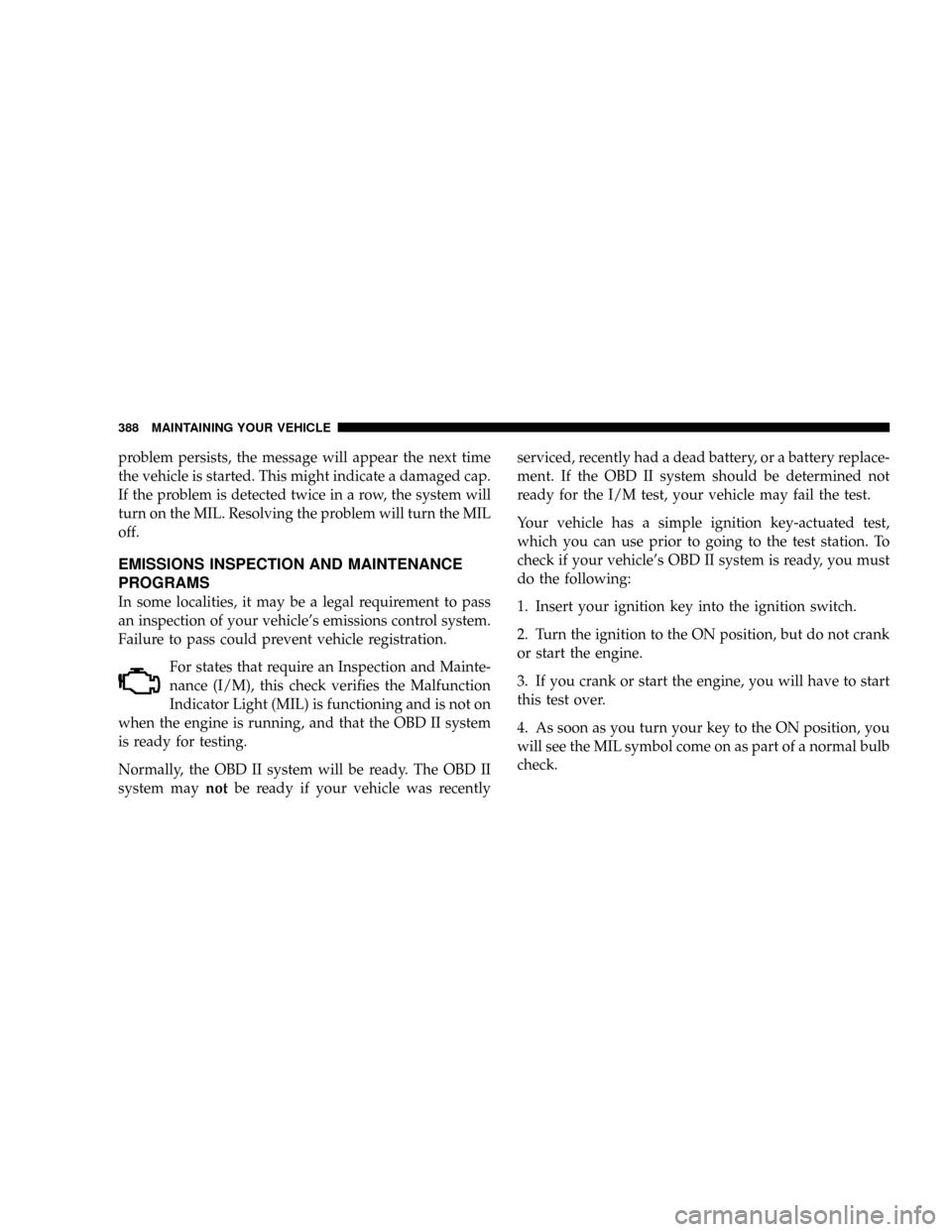
problem persists, the message will appear the next time
the vehicle is started. This might indicate a damaged cap.
If the problem is detected twice in a row, the system will
turn on the MIL. Resolving the problem will turn the MIL
off.
EMISSIONS INSPECTION AND MAINTENANCE
PROGRAMS
In some localities, it may be a legal requirement to pass
an inspection of your vehicle's emissions control system.
Failure to pass could prevent vehicle registration.
For states that require an Inspection and Mainte-
nance (I/M), this check verifies the Malfunction
Indicator Light (MIL) is functioning and is not on
when the engine is running, and that the OBD II system
is ready for testing.
Normally, the OBD II system will be ready. The OBD II
system maynotbe ready if your vehicle was recentlyserviced, recently had a dead battery, or a battery replace-
ment. If the OBD II system should be determined not
ready for the I/M test, your vehicle may fail the test.
Your vehicle has a simple ignition key-actuated test,
which you can use prior to going to the test station. To
check if your vehicle's OBD II system is ready, you must
do the following:
1. Insert your ignition key into the ignition switch.
2. Turn the ignition to the ON position, but do not crank
or start the engine.
3. If you crank or start the engine, you will have to start
this test over.
4. As soon as you turn your key to the ON position, you
will see the MIL symbol come on as part of a normal bulb
check.
388 MAINTAINING YOUR VEHICLE